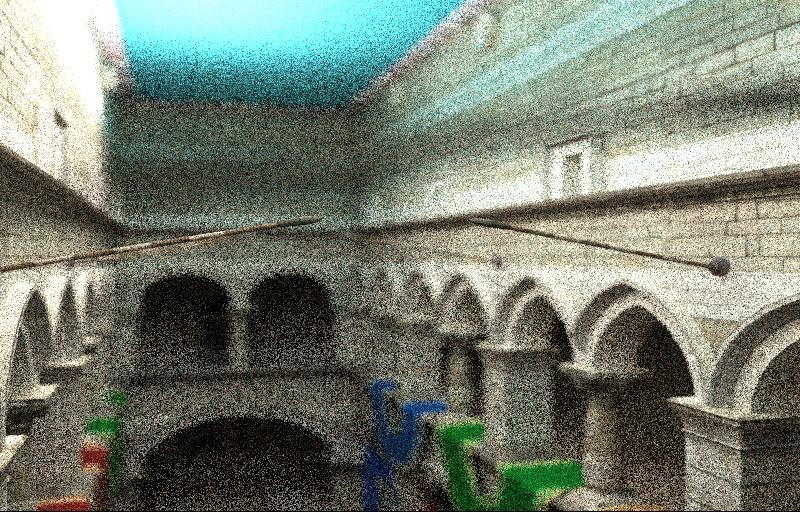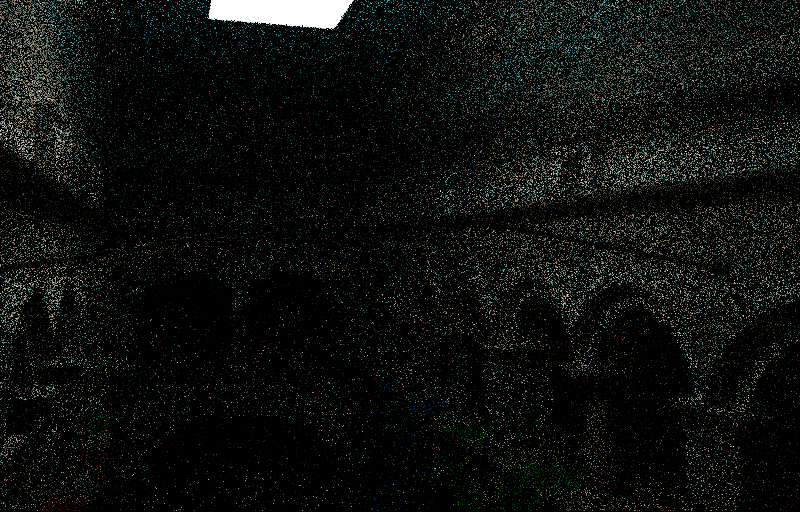Hello everybody,
I am new in this forum and I am a newbie in the computer graphics field. I need some help in my project that I keep bringing on since months without big results. What I am trying to implement on my own is a gradient domain path tracer in C++:
https://mediatech.aalto.fi/publications/graphics/GPT/
Before arriving at the main algorithm itself, I am trying to build my own path tracer where afterward I can work on the GDPT. Due to my lack of knowledge in computer graphics, results so far are not great. What I have tried to follow so far is this implementation that contains both a simple Path Tracer and a GDPT built on it:
So I tried to reproduce this code on my framework, I am going to explain you slowly the problem but it just needs a bit or prerequisites. The rest is just the implementation of the rendering equation that somehow is wrong.
First of all: the following is the definition of a struct (will be declared and initialized later), containing some scene info needed to cast ray from the camera into the scene.
struct RenderData
{
vec3 E;
vec3 p1;
vec3 dx;
vec3 dy;
};
It is initialized in the InitializeScene method:
void InitializeScene(){ // setup virtual screen plane
vec3 E( 2, 8, -26 ); //Eye position
vec3 V( 0, 0, 1 ); //LookAt vector
float d = 0.5f, ratio = SCRWIDTH / SCRHEIGHT, focal = 18.0f;
vec3 p1(E + V * focal + vec3(-d * ratio * focal, d * focal, 0)); // top-left screen corner in SCREEN SPACE
vec3 p2(E + V * focal + vec3(d * ratio * focal, d * focal, 0)); // top-right screen corner
vec3 p3(E + V * focal + vec3(-d * ratio * focal, -d * focal, 0)); // bottom-left screen corner
mat4 M = rotate( mat4( 1 ), r, vec3( 0, 1, 0 ) );
p1 = vec3(M * vec4(p1, 1.0f)); //rotating the above points
p2 = vec3(M * vec4(p2, 1.0f));
p3 = vec3(M * vec4(p3, 1.0f));
renderData.dx = (p2 - p1) / (float)SCRWIDTH;
renderData.dy = (p3 - p1) / (float)SCRHEIGHT;
renderData.E = vec3(M * vec4(E, 1.0f));
renderData.p1 = p1;
}
The code above is to make you understand how I initialized the scene. I also have structs to store informations about my paths:
struct PathVert {
vec3 p; vec3 n; //hit point and normal of the surface hit
};
struct Path {
PathVert verts[MAX_DEPTH]; //maxDepth is 15 for now
int vertCount;
int x, y; //which pixel this path is referring to
};
therefore I start consider pixel after pixel.
for (int y = 0; y < SCRHEIGHT; y++) for (int x = 0; x < SCRWIDTH; x++)
{
Path path;
if(generatePath(x,y, path)){
Sample(path);
}
}
The generatePath() method indeed tracks the path into the scene and checks all the vertices it hits. The checkIfRayIntersectSomething(t) method you will see used, it’s just a pseudo method implemented in my framework and that I omit posting cause of its length. I use it to check if my ray hits something in the scene, if it does, it update the “t” with the distance to that object. NOTE: the light is not considered an object itself. Hence, I also have a checkRayLightIntersection(hitLightPoint) which checks the intersection with the light, if there is any, the hitLightPoint is updated with the point on the light I have been hitting. The light is a 2D surface.
Vec lightPos = Vec(5, 15, 2); //hard coded position of the light
And the light, as said, is a surface, but exactly a square surface, whose 4 angles are:
Vec P1 = Vec(lightPos.x - 20, lightPos.y, lightPos.z + 20);
Vec P2 = Vec(lightPos.x + 20, lightPos.y, lightPos.z + 20);
Vec P3 = Vec(lightPos.x + 20, lightPos.y, lightPos.z - 20);
Vec P4 = Vec(lightPos.x - 20, lightPos.y, lightPos.z - 20);
Quite big, I know, so the first question relies on this aspect, is it correct having such a big light?
But let’s go to the main methods. Hereby you can see the GeneratePath method:
bool GeneratePath(int x, int y, Path &path){
path.x = x;
path.y = y;
path.vertCount = 0;
vec3 P = renderData.p1 + renderData.dx * ((float)(x) + Rand(1)) + renderData.dy * ((float)(y) + Rand(1));
vec3 O = renderData.E + vec3(Rand(0.4f) - 0.2f, Rand(0.4f) - 0.2f, Rand(0.4f) - 0.2f);
vec3 D = normalize(P - O); //direction of the first ray, the one from the camera towards the pixel we are considering
for (int depth = 1; depth <= MAXDEPTH; depth++){
float t;
Vec hitLightPoint;
PathVert vert;
if (!checkIfRayIntersectSomething(t)){
//we didn't find any object.. but we still may have found the light which is an object non represented in the scene
//the depth check avoids me rendering the light as a white plane
if (depth > 1 && checkRayLightIntersection(O, D, hitLightPoint)){
//update the vertex since we realized it's the light
vert.p = hitLightPoint;
vert.n = Vec(0, -1, 0);//cause the light is pointing down
path.verts[depth - 1] = vert;
path.vertCount++;
return true; //light hit, path completed
}
return false; //nothing hit, path non valid
}
//otherwise I got a hit into the scene
vert.p = O + D * t; //reach the hitPoint
vert.n = methodToFindTheNormal();
vert.color = CalculateColor(vert.p); //according to the material properties (only diffuse objects so far)
path.verts[depth - 1] = vert;
path.vertCount++;
//since I have the light, and a path terminates when it hits the light, I have to check out also if my ray hits this light,
//and if does, I have to check whether it first hits the light or the object just calculated above
//moreover with the "depth > 1" check, I avoid again rendering the light which otherwise would be visible as a white plane
if (depth > 1 && checkRayLightIntersection(O, D, hitLightPoint)){
float distFromObj = length(vert.p);
float distFromLight = length(hitLightPoint);
if (distFromLight < distFromObj){
//update the vertex since we realized it's the light
vert.p = hitLightPoint;
vert.n = Vec(0, -1, 0);
vert.color = Vec(1, 1, 1);// TODO light color? or light emission?
path.verts[depth - 1] = vert;
return true; //light hit, path completed
}
}
if (depth == MAXDEPTH) return false;
Vec newDir = BSDFDiffuseReflectionCosineWeighted(vert.n, D);//explained later
D = newDir;
O = vert.p;
}
return false;
}
The BSDFDiffuseReflectionCosineWeighted() just calculate the new directions, tested and working. What remains last is the Sample method which calculates the final color of the pixel.
Vec Sampling(Path &path){
Vec color(1, 1, 1);
for (int vert = 0; vert < path.vertCount - 1; vert++) { //considers the last vertex as the light
const PathVert &currVert = path.verts[vert];
const PathVert &nextVert = path.verts[vert + 1];
Vec wo = (nextVert.p - currVert.p).norm();
double cosTheta = fabs(wo.dot(currVert.n));
float PDF = cosTheta/PI;
if (cosTheta <= 1e-6) return Vec();
//considering only DIFFUSE objects
color = color.mult(currVert.color * (cosTheta / M_PI) / PDF);
}
return color.mult(Vec(10.0f, 10.0f, 10.0f)); //multiplication for the light emission?
}
Result with 16SPP is:
My target reference image is instead:
In my target reference framework, the light is much smaller… it has a size of 2x2, but if in my case I make the light of the same size, this is what happens (showing on purpose the light)
In all the images above the SPP are 16. Therefore I aim to obtain a good image like the target one with a low SPP. There is something wrong witht he implementation of the rendering equation which is mainly in the Sampling method. I would be glad if you could help me understanding where the problem is, I rely on the fact that I apply wrongly the PDF or something like that, or that a term is missing in the rendering equation but I have been passing through the theory many many times already, seeing no error. Thanks in advance


